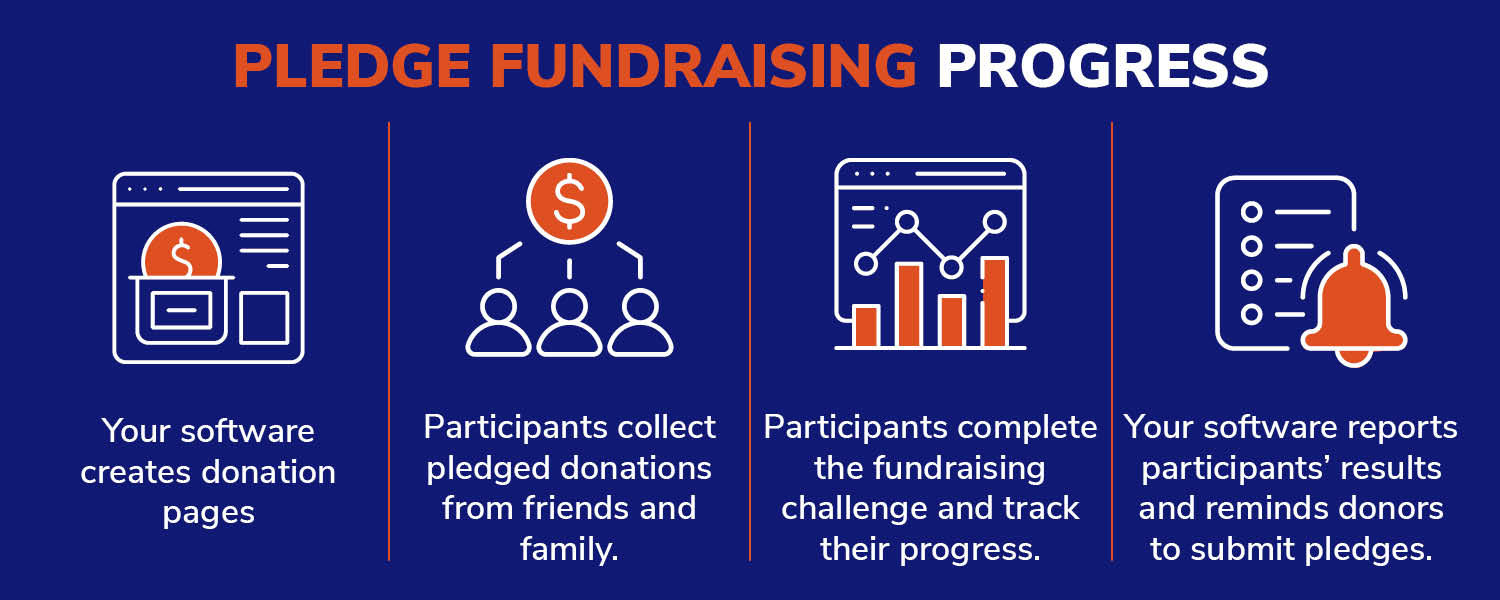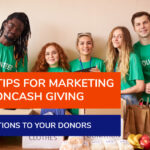Navigating the Season of Giving: 5 Fundraising Software Tips

As a fundraiser, you know how critically important year-end fundraising is. For many organizations, the last quarter of the year is the time when they collect a significant portion of the incoming year’s funding. And because supporters feel more inclined to donate during this season, nonprofits focus all of their energy on fundraising.
As a result, year-end fundraising can feel hectic. The fundraising landscape often becomes crowded, adding another challenge to the mix. In order to stand out, manage time and resources effectively, and give donors the best experiences possible, consider leveraging specialized fundraising software.
In this guide, we’ll explore the ways that you can use your software to its full potential during the season of giving:
- Make giving convenient.
- Easily organize pledge fundraisers.
- Gamify fundraising progress.
- Expand your audience.
- Offer multiple ways to give.
While your fundraising tool won’t lead you to the perfect fundraising idea or reveal earth-shattering marketing strategies to reach your target audience, it can make a significant impact on donors’ overall experience through small changes. Over time, this boosts donor loyalty, satisfaction, and retention. Let’s get started by exploring how you can achieve these benefits.
1. Make giving convenient.
Technology enables people to give online in the way that is easiest for them. With more people gravitating toward a cashless lifestyle, accepting a variety of online payment methods is a must for nonprofits wishing to achieve their fundraising goals.
Fundraising software typically has built-in payment processors or partners with tools that accept online payments. Ideally, your software should accept payments via:
- Debit and credit cards
- ApplePay
- GooglePay
- PayPal, Venmo, CashApp, and/or other third-party processors
- Text-to-give campaigns
It’s worth noting that these online giving methods are also much more convenient for your nonprofit. You won’t need to make any trips to the bank to deposit cash or checks, and your fundraising progress will remain updated and accurate.
2. Easily organize pledge fundraisers.
Pledge fundraisers are a form of crowdfunding in which participants fundraise among their friends and families on behalf of your organization to collect pledged donations. Usually, these donations are fulfilled after the fundraiser ends, either in a lump sum or in installments.

Pledges can be based on a participant’s performance in some kind of event or challenge. For example, 99Pledges’ guide to read-a-thons breaks down the process like this:
- Work with your software provider to set up fundraising pages for your organization and individual participants.
- Each participant collects pledged donations from their friends and family. They may donate a flat fee or a set dollar amount per minute read (e.g., $5 per hour).
- While they are fundraising, participants work hard to read as much as possible and track their progress.
- After the fundraiser, your software reports each participant’s results, and donors submit pledged donations. A donor who pledged $5 per hour would donate a total of $50 if their participant read for 10 hours.
When using specialized software, it’s easy to get these fundraisers up and running quickly for important occasions like Giving Tuesday. Additionally, the participants take on most of the fundraising responsibilities, freeing up staff time during the busy season.
3. Gamify fundraising progress.
Gamification is a method used by many organizations to motivate their supporters to participate in fundraisers. Specifically, this strategy involves applying elements of gameplay, like scoring points and competing against other “players,” to inspire supporters to engage with your campaign.
This strategy is especially effective for schools and other youth-focused organizations because kids enjoy competing for prizes and recognition. But, if your nonprofit’s participants are usually adults, you can still offer prizes such as free branded merchandise or recognition on your website.
Using your software to carefully track each participant’s fundraising progress, you might apply gamification strategies like:
- Donation milestone: Based on past fundraising data, set donation milestones with corresponding recognition and/or rewards. You might set milestones at $100, $250, and $500+, offering digital badges to those who meet the lower milestones and prizes for participants who go above and beyond. Additionally, consider creating small, named groups for each milestone so donors feel like part of a niche community.
- Publish leaderboards: Create and share real-time leaderboards that show off the top fundraisers in your campaign. Not only does this show supporters how much progress your campaign is making, but it also allows them to see what the “competition” looks like. If a participant realizes they are only a few dollars away from entering the list of the top 10 fundraisers, they may work harder to secure an additional gift.
- Impact tracking: Add fun visuals or animations that depict the impact each donation has. For example, the United Nations World Food Programme (WFP) has a “free rice” game in which players answer questions related to vocabulary, history, and other categories, earning 10 grains of rice per correct answer. As they earn points, an illustration shows a bowl filling with rice and vegetables. Consider creating something similar that aligns with your mission based on the fundraising dollars participants earn.
This information can come in handy later, so remember to save it. Your nonprofit could analyze the data from the fundraiser to refine future campaigns and marketing efforts. For example, you might create a donor segment for those who earned the most during the fundraiser and then thank them for their help, ask them to join your volunteer program, and recruit them to work on future campaigns.
4. Expand your audience.
Fundraising software makes it incredibly easy to take your existing fundraisers online where you’ll be able to reach potential supporters from around the world. By sharing links to your donation pages online, you can grow your audience well beyond your local community.
To expand your network of supporters, remember to:
- Create engaging social media posts that link to donation pages.
- Refine your website so that it is mobile-responsive and easy for supporters to navigate to your donation form.
- Leverage platforms like email and text marketing.
- Personalize communications sent to repeat donors by greeting them by name and acknowledging their last gift.
- Promptly send welcome messages to new supporters.
Once you reach new supporters and inspire them to give, make an effort to retain them via donor appreciation efforts. eCardWidget’s page on holiday eCards recommends reaching out for major holidays like New Year’s, Christmas, Hanukkah, Mother’s and Father’s Day, and Valentine’s Day. This will help you maintain contact with donors during the year-end giving season and beyond, keeping your nonprofit at the forefront of their minds while showing that you care about them.
5. Offer multiple ways to give.
The holidays are a stressful time, but giving to your nonprofit should be easy. Provide supporters with the information they need to understand how to give in whatever way is most convenient for them.
To accomplish this, try creating a “Ways to Give” page on your website that highlights multiple giving methods. For example, you might provide directions for how supporters can get involved through:
- Recurring gifts. One-time gifts around the holidays are appreciated, but what’s even better is when those last-minute annual gifts instead become recurring support. Explain how supporters can easily opt-in to make their donations on a recurring monthly basis, meaning they will give automatically each month without having to do any extra work.
- Volunteering. Some supporters may also be interested in donating their time. Discuss open volunteer positions as well as recurring roles for supporters interested in volunteering more as part of their New Year’s resolution.
- Workplace giving. Some of your supporters may be able to give more through their employer’s corporate social responsibility (CSR) program. Explain workplace giving programs like matching gifts and volunteer grants and how supporters can check their eligibility by looking at their employer’s handbook, logging onto their company’s CSR software, or most convenient of all, using a matching gift database to search for their employer.
- In-kind donations. Rather than making a monetary donation, it might be equally beneficial to your nonprofit for supporters to donate tangible items directly. For example, a homeless shelter might request donations of warm blankets, coats, hats, and socks. Provide directions for what kinds of items you’ll accept and where supporters can deliver them.
Feature this page prominently on your website by adding a link to it in your navigation. For instance, you might link it under a menu item titled “Get Involved,” so supporters looking for a range of engagement activities can easily find it.
The end of the year may feel stressful, high-pressure, and hectic—but it doesn’t have to. These strategies will help you leverage the benefits and capabilities of your fundraising software to alleviate year-end stressors while yielding impressive results.


